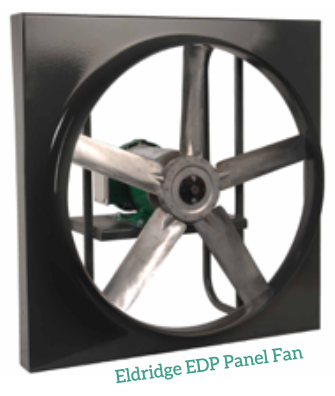Replacing Fans
When replacing fans used for general ventilation customers sometimes ask if the replacement fans can provide more airflow without increasing the fan size. Before providing the customer an answer, we need to assess their fans and evaluate the options for adding more airflow. In this article, we will discuss the options for increasing airflow utilizing the same size fan and the factors that may limit those options.
Options for Increasing Airflow
When comparing a customer’s existing fans with replacement Eldridge E-Fans of the same size, there are several options that we evaluate to determine what option or combination of options will work best to provide additional airflow:
- Blade Style – Some fans are made with pressed blades that do not move air very efficiently. Replacing these fans with Eldridge E-Fan that has an airfoil style blade will move more air with the same amount of horsepower.
- Blade Pitch Angle – Eldridge E-Fans have adjustable pitch blades that can be set from 10˚ to 35˚. Increasing the pitch angle will provide more airflow. However, doing this may require more horsepower.
- Propeller Speed – The faster that a fan propeller turns, the more airflow it will provide. The propeller speed on a direct drive fan is increased by using a motor that has a higher speed. For a belt drive fan, the propeller speed can also be increased by reducing the sheave on the propeller drive shaft relative to the sheave on the motor drive shaft. Increasing the propeller speed may require more horsepower.
- Reduce Pressure Drops – Removing components of the building ventilation system that are causing pressure drops is another option for increasing airflow. We won’t recommend removing equipment such as fan guards or filter boxes, but replacing backdraft dampers, louvers and hoods may reduce the system pressure drop and increase airflow.
Limitations
Getting more airflow from the same size fan does have some limitations. However, in this situation, the usual limitations such as cost and efficiency become secondary to the limitations of noise and motor size.
- Noise – Increasing blade pitch angle and propeller speed will cause the noise level produced by a fan to increase. Safety regulations will dictate that the noise level be kept below 85 dBA in proximity to workers. However, even at that level, the noise may be uncomfortable to some people working near the fan. It would defeat the purpose of adding more airflow if the workers are turning the fan off due to more noise. The amount of additional noise that is acceptable in a customer’s particular work environment must be carefully evaluated before making any changes.
- Motor Size – Increasing blade pitch angle and propeller speed will require more horsepower. As the horsepower increases, so does the frame size of the motor. For each size of Eldridge E-Fans, there is a maximum limit to the motor frame size that it can accommodate. Therefore, the real limitation to the maximum rated airflow possible for each Eldridge E-Fan size is the maximum allowable motor frame size.
- Additional Pressure Drop – Considering that any ventilation system is a balance between supply and exhaust airflows, any increase in airflow on one side of the ventilation system will have an impact on the other. If louvers are on the other side, then the increased airflow will result in a higher air velocity through the louver unless the louver size is increased. Assuming that the same “no increase in size” requirement applies to the louvers, then the higher air velocity will cause a higher pressure drop which will need to be included in determining the pressure of the fans.
Conclusion
If you want to get more airflow into your building, but don’t want to increase the size of openings in the walls or roof, Eldridge can help. Whether simple or complex, an Eldridge team member can evaluate the ventilation system in your building and present options for getting more airflow. Call Eldridge to get started now. The hot summer months are just ahead!

